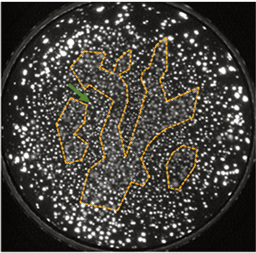Published online by Cambridge University Press: 03 September 2021

Three-dimensional field ion microscopy is a powerful technique to analyze material at a truly atomic scale. Most previous studies have been made on pure, crystalline materials such as tungsten or iron. In this article, we study more complex materials, and we present the first images of an amorphous sample, showing the capability to visualize the compositional fluctuations compatible with theoretical medium order in a metallic glass (FeBSi), which is extremely challenging to observe directly using other microscopy techniques. The intensity of the spots of the atoms at the moment of field evaporation in a field ion micrograph can be used as a proxy for identifying the elemental identity of the imaged atoms. By exploiting the elemental identification and positioning information from field ion images, we show the capability of this technique to provide imaging of recrystallized phases in the annealed sample with a superior spatial resolution compared with atom probe tomography.